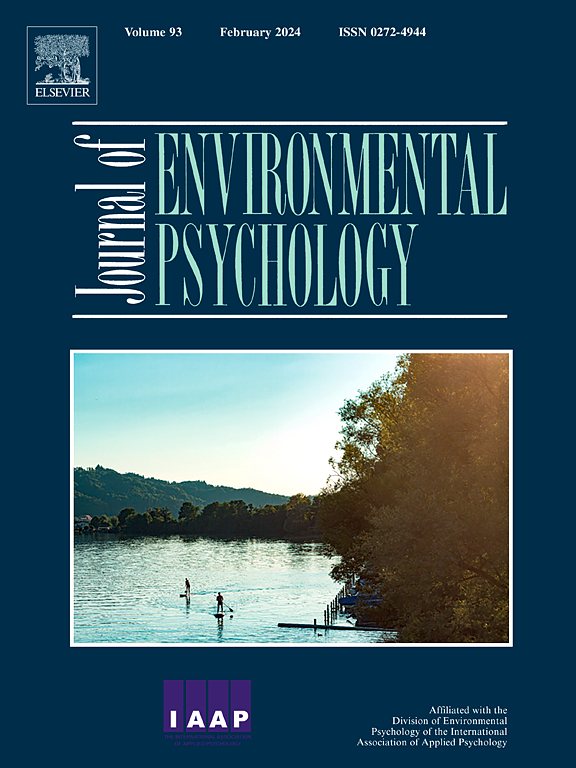自然声景通过能力建设和能力恢复途径与心理健康相关联
IF 7
1区 心理学
Q1 ENVIRONMENTAL STUDIES
引用次数: 0
摘要
来自自然区域的声景观是一种重要的文化生态系统服务,可以促进更大的心理健康和福祉。然而,发生这种情况的中介途径尚未完全了解,限制了它们融入生态系统服务框架。我们通过研究自然声景和幸福感的主观和客观测量之间的一系列中介途径来解决这一差距。通过在线调查,一个有代表性的英国样本(N = 1529)听取了三个声学指标不同水平的模拟自然声景。参与者完成了主观幸福感和感知恢复的测量,以及对声景中鸟类多样性、恢复性、压力和敬畏的感知。然后使用结构方程模型来测试理论表明的声景和幸福感的主观和客观测量之间的路径。结果证实了生物多样性-健康假说:感知到的鸟类多样性和幸福感之间的关系是由更大的感知到的音景恢复性质量、更少的感知压力和更大的敬畏感所介导的。声学特性和幸福感之间的新机制途径也被证明具有中等到高度的声学复杂性,通过一系列中介途径对幸福感产生间接影响:首先通过更高的感知生物多样性水平,然后通过更大的感知恢复性,减少感知压力或增加敬畏。这些结果为自然声景观如何带来福祉提供了新的见解,并可以为自然区域声景观的管理和评估提供信息。本文章由计算机程序翻译,如有差异,请以英文原文为准。
Natural soundscapes are associated with mental well-being via capacity-building and capacity-restoring pathways
Soundscapes from natural areas are an important cultural ecosystem service that can promote greater mental health and well-being. However, the mediating pathways by which this occurs are not yet fully understood, limiting their integration into ecosystem service frameworks. We addressed this gap by examining a range of mediating pathways between subjective and objective measures of natural soundscapes and well-being. Using online surveys, a representative UK sample (N = 1529) listened to simulated natural soundscapes with differing levels of three acoustic metrics. Participants completed measures of subjective well-being and perceived restoration, along with perceptions of bird diversity within soundscapes, restorativeness, stress and awe. Structural equation modelling was then used to test the theoretically-indicated pathways between subjective and objective measures of the soundscapes and well-being. Results confirmed biodiversity-health hypotheses: the relationship between perceived bird diversity and well-being was mediated by greater perceived restorative qualities of the soundscape, reduced perceived stress and greater perceptions of awe. Novel mechanistic pathways between acoustic characteristics and well-being were also demonstrated with moderate to high acoustic complexity displaying an indirect effect on well-being via serial mediation pathways: first through higher perceived biodiversity levels, and then either greater perceived restorativeness, reduced perceived stress or increased awe. These results provide new insights into how natural soundscapes can deliver well-being benefits and can inform the management and valuation of soundscapes in natural areas.
求助全文
通过发布文献求助,成功后即可免费获取论文全文。
去求助
来源期刊

Journal of Environmental Psychology
Multiple-
CiteScore
10.60
自引率
8.70%
发文量
140
审稿时长
62 days
期刊介绍:
The Journal of Environmental Psychology is the premier journal in the field, serving individuals in a wide range of disciplines who have an interest in the scientific study of the transactions and interrelationships between people and their surroundings (including built, social, natural and virtual environments, the use and abuse of nature and natural resources, and sustainability-related behavior). The journal publishes internationally contributed empirical studies and reviews of research on these topics that advance new insights. As an important forum for the field, the journal publishes some of the most influential papers in the discipline that reflect the scientific development of environmental psychology. Contributions on theoretical, methodological, and practical aspects of all human-environment interactions are welcome, along with innovative or interdisciplinary approaches that have a psychological emphasis. Research areas include: •Psychological and behavioral aspects of people and nature •Cognitive mapping, spatial cognition and wayfinding •Ecological consequences of human actions •Theories of place, place attachment, and place identity •Environmental risks and hazards: perception, behavior, and management •Perception and evaluation of buildings and natural landscapes •Effects of physical and natural settings on human cognition and health •Theories of proenvironmental behavior, norms, attitudes, and personality •Psychology of sustainability and climate change •Psychological aspects of resource management and crises •Social use of space: crowding, privacy, territoriality, personal space •Design of, and experiences related to, the physical aspects of workplaces, schools, residences, public buildings and public space
 求助内容:
求助内容: 应助结果提醒方式:
应助结果提醒方式:


